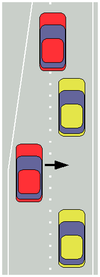Merge (traffic)

In traffic engineering, the late merge or zipper method is a convention for merging traffic into a reduced number of lanes. Drivers in merging lanes are expected to use both lanes to advance to the lane reduction point and merge at that location, alternating turns.
The late merge method contrasts with the early merge method. A related scheme is the dynamic late merge.
The late merge method has not been found to increase throughput (throughput is the number of vehicles that pass through a point in a given period of time). However, it considerably reduces queue ("backup") length (because drivers use the ending lane until its end) and reduces speed differences between the two lanes, increasing safety.[1]
Governments hold campaigns to promote the late merge method because irritation, aggression and feelings of insecurity easily occur while "zipping". Often drivers who change lanes too early do not like to see other drivers continue until the end of the drop-away lane, even though this late merging is encouraged by the authorities. In Belgium and Germany, a driver can be penalized for not using the late merge method. In Austria only where a traffic sign so indicates.
Most states in the United States require merging traffic to yield to through traffic which already exists in the lane they wish to enter. This further complicates the common understanding of proper merging protocol, as even though zipper merging is widely encouraged, those doing so are still legally required to yield, and those who choose not to let them merge are not technically doing anything wrong legally.

Late merge with more than two lanes in right-hand side traffic

The merging of three to two lanes makes a pattern which is more complicated than the one that is made by the merging of two to one lane. In an ideal situation, there actually arise two "zippers" now:
- one out of every two vehicles moves from the middle lane towards the right lane, where after every two vehicles, a gap is sought;
- afterwards, two vehicles merge from the left lane to the gap in the middle lane.
In case the two left lanes would merge according to the late merge method described before (two to one), the new left lane will have twice as many vehicles as the right lane. A fourth of the number of vehicles on the new left lane will eventually choose the (faster and less occupied) right lane, bringing the number of vehicles in both lanes back to an equal number.
References
- ↑ Johnson, Ken. "Late Merge...the Zipper System" (PDF). Minnesota DOT. Retrieved 30 April 2013.
Further reading
- Vanderbilt, Tom (2008), Traffic: why we drive the way we do (and what it says about us), Knopf, pp. 3–5, 46–50, 309, ISBN 978-0-307-39772-0